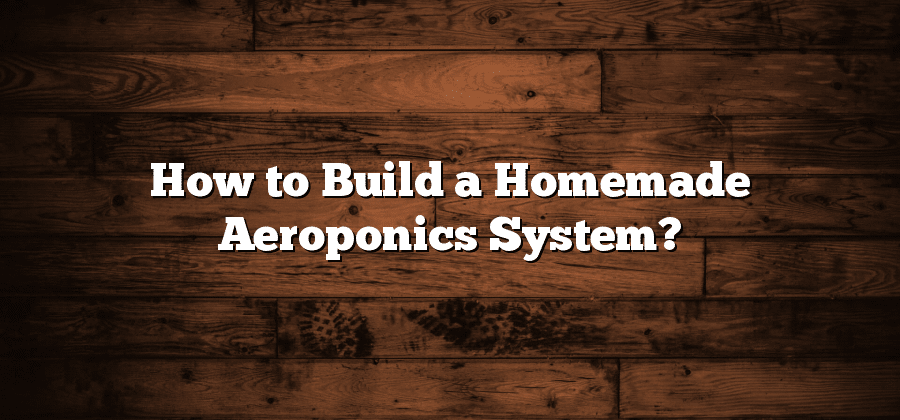Materials and Tools Needed for Aeroponics System
To set up a successful aeroponics system, it is crucial to gather all the necessary materials and tools. First and foremost, you will need a strong and durable structure to hold your plants. Consider using PVC pipes or sturdy metal frames to construct the framework. Additionally, you will require high-quality and lightweight growing containers that provide sufficient support and drainage for the plants.
Investing in a reliable pump is essential for maintaining a constant flow of nutrient-rich water to the roots. Look for a pump that is specifically designed for aeroponics systems, ensuring it has the necessary power and capabilities. Moreover, you will need a reliable timer to automate the watering cycles and control the duration of misting sessions. This will help optimize the growth and health of your plants. Lastly, a pH meter and electrical conductivity (EC) meter are indispensable tools to measure and adjust the level of acidity and nutrient concentration in the water.
Choosing the Right Location for Your Aeroponics System
When determining the optimal location for your aeroponics system, there are several factors to consider. Firstly, you will need a space that receives ample sunlight throughout the day. Ideally, the location should have at least 6 to 8 hours of direct sunlight to ensure the healthy growth of your plants.
Additionally, it is important to choose a location that is well-ventilated. Adequate air circulation is crucial for preventing the buildup of humidity, which can lead to the growth of mold and other pathogens. The presence of a gentle breeze or access to a fan can help in maintaining proper airflow within the aeroponics system.
Moreover, it is advisable to select a location that is easily accessible for maintenance tasks. Regular monitoring and maintenance are essential for the efficient functioning of the system and the well-being of your plants. Therefore, choosing a location that allows you to easily reach the reservoir, sprayers, and any other components will make the upkeep of your aeroponics system more convenient.
In conclusion, finding the right location for your aeroponics system involves considering factors such as sunlight exposure, ventilation, and accessibility. By carefully selecting a suitable location, you will create a favorable environment for your plants to thrive in the aeroponic system.
Designing the Structure of Your Aeroponics System
The structure of your aeroponics system is an important aspect to consider when setting up your indoor garden. It provides the framework and support for your plants, ensuring their healthy growth and development. When designing the structure, it is crucial to prioritize strength and stability to prevent any accidents or damage to the system.
One key factor to consider is the material of the structure. It is recommended to use sturdy and durable materials such as metal or high-quality plastic. These materials can withstand the weight of the plants and the constant exposure to moisture. Additionally, consider the size of your garden and the number of plants you intend to grow. This will help determine the dimensions and layout of the structure to accommodate the desired plant capacity efficiently. Remember to allocate enough space between each plant to allow for proper airflow and easy access during maintenance. With a well-designed structure, you can ensure an efficient and productive aeroponics system for your indoor gardening needs.
Setting Up the Reservoir for Your Aeroponics System
One of the crucial components of an aeroponics system is the reservoir, which serves as the storage for the nutrient solution. When setting up the reservoir for your aeroponics system, there are a few key factors to consider. First and foremost, it is essential to choose a reservoir that is large enough to hold an adequate amount of nutrient solution for your plants. This will depend on the size and number of plants you intend to grow.
Another important aspect to consider is the material of the reservoir. It is recommended to use a reservoir made of a food-grade, non-toxic material such as high-density polyethylene (HDPE) or polypropylene. These materials are durable, resistant to chemical leaching, and will not introduce any harmful substances into the nutrient solution. Additionally, ensure that the reservoir is lightproof to prevent the growth of algae, as exposure to light can trigger this unwanted phenomenon. Properly setting up the reservoir will lay a solid foundation for the success of your aeroponics system.
Selecting the Appropriate Aeroponic Sprayers
When it comes to selecting the appropriate aeroponic sprayers for your system, there are a few key factors to consider. First and foremost, you need to determine the size and type of plants you will be growing. Different sprayers have varying spray patterns and nozzle sizes, so it is important to choose ones that will effectively distribute the nutrient solution to your plants.
Additionally, it is important to consider the pressure and flow rate of the sprayers. The pressure should be sufficient to create a fine mist that can easily reach all parts of the plants’ roots, while the flow rate should be adjusted to meet the specific needs of your plants. It is also crucial to choose sprayers that are durable and made from high-quality materials, as they will need to withstand continuous use and exposure to the nutrient solution.
In summary, selecting the appropriate aeroponic sprayers for your system is a crucial step in ensuring the success of your aeroponic setup. Understanding the needs of your plants and considering factors such as spray pattern, nozzle size, pressure, flow rate, and durability will help you make an informed decision. By choosing the right sprayers, you can effectively deliver the necessary nutrients to your plants, promoting healthy growth and maximizing your aeroponic system’s potential.






